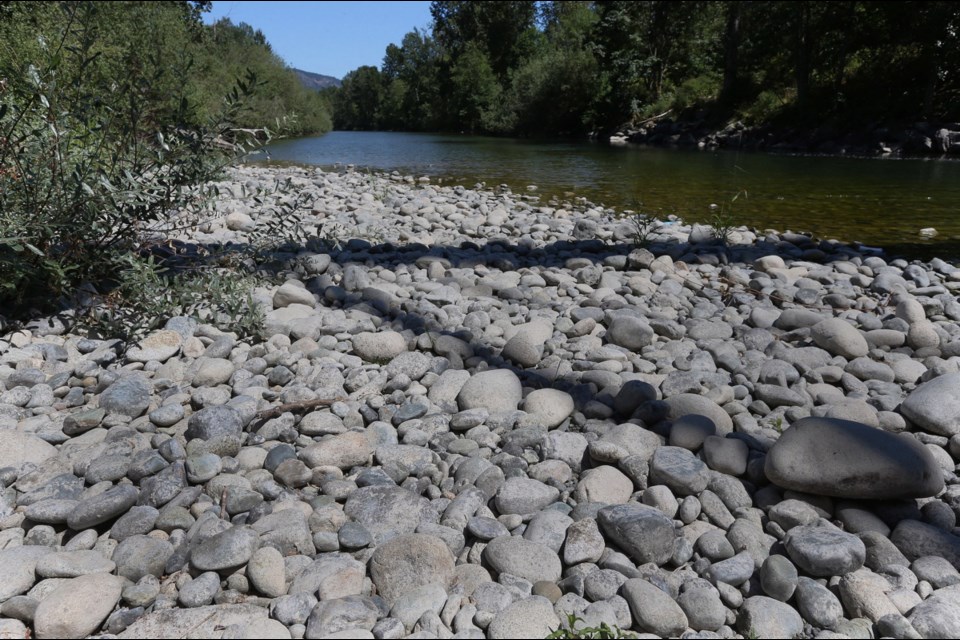Cowichan Tribes Chief Chip Seymour has watched the once robust Cowichan River reduced to a mere stream.
Drought conditions are stranding salmon fry in warm pools, he said, and hampering mature chinook from completing their spring run up to Cowichan Lake.
“It’s hard to look at the river,” Seymour said.
“Our concerns are always for our fish, our water supply, the wildlife that gets sustained by our river flows. It affects so many things.”
A long-term solution seems desperate. But stakeholders say one has already been identified: Raise the weir.
The problem is, it hasn’t been implemented.
“At this point, it’s the only solution. Until they can ensure there’s adequate water supply, there’s just no other way of looking at it,” Seymour said.
Rodger Hunter, co-ordinator of the Cowichan Watershed Board, said the challenge is that it’s unclear who should take out a licence and where funding will come from. Increasing water storage would benefit many — from the provincial government to a mill downstream.
“I think the issue is that we have diffuse responsibility and accountability.”
The weir, owned and operated by Catalyst Paper, controls the river’s flow out of the Cowichan Lake. But conditions have changed since its 1956 construction, Hunter said.
Lower precipitation rates and higher temperatures have meant average in-flows dropped by 36 per cent between the 1980s and 2010. And it’s only getting worse, he said.
Raising the weir was one of the main recommendations that came out of a 2007 report on the river called the Cowichan Basin Water Management Plan. It was the result of more than two years of technical reports and input from a citizens forum.
It’s the same strategy that has granted Greater Victoria residents plenty of drinking water this season. The Sooke Lake reservoir was raised 12 years ago and it’s expected to drop only to 59 per cent capacity in November, if exceptionally dry conditions continue.
“I view Cowichan Lake as this big bank of water. What you do, is budget until the fall, when you hope it gets filled up again,” Hunter said. “The issue is getting the water into the bank account to spend it in the summer.”
One obstacle was a 2013 legal challenge from lakefront property owners, who feared losing land if water levels rose.
The environmental appeal board ruled against them.
Although the ruling came in response to a application for a different purpose, raising the water level inside the weir, river stewards believe it set a precedent to raise the weir.
Another obstacle is cost. Jon Lefebure, chairman of the Cowichan Valley Regional District, estimated the weir could cost upward of $10 million. The CVRD has applied to the Gas Tax Strategic Priorities Fund for two-thirds of it, but won’t know until fall if it will be granted.
A spokesman for the Ministry of Forests, Lands and Natural Resource Operations said no provincial funding is available at this time.
He also said no one has applied for a water licence to date.
From the stakeholders’ perspective, it’s a community responsibility. Rob Belanger, vice-president and general manager of Catalyst Paper’s Crofton mill, said any move to raise the weir should come through group consensus.
“Raising the weir is something for the whole community to engage in,” Belanger said.
“There have been huge benefits for a whole bunch of people, so any changes to that, I think, really need to be done through consultation of the stakeholder group.”
Ted Brookman, inland fisheries chairman for the B.C. Wildlife Federation, said the challenge facing the Cowichan River isn’t unique.
“The rivers up-Island are as bad as they are down-Island. Some of the creeks … are bone-dry,” he said.
“If the river goes dry, we all lose. So we need to work together.”



